| According to a 1988 report, 81 of Arizona’s 115 threatened vertebrate species are either closely associated with, or completely dependent upon, riparian habitat; 70% of those species require riparian habitat to survive. (AGFD 1988) |
|
|
|
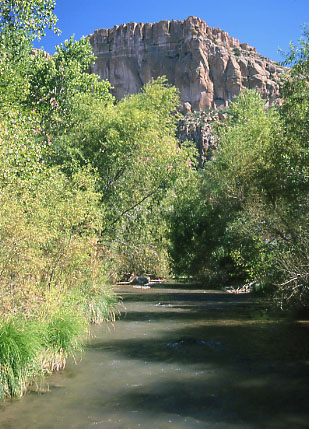 |
Willows lining the banks provide habitat for birds and cooling shade for native fish.
Aravaipa Canyon Wilderness, AZ. October 1998. |
| Let’s look at a rare, healthy riparian forest in southern New Mexico. |
|
|
|
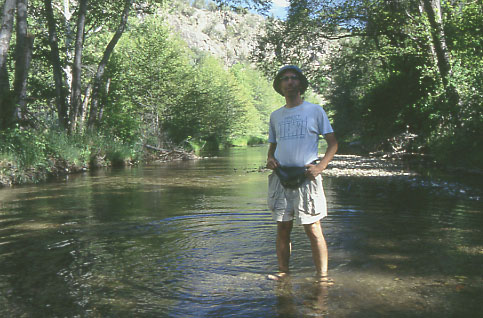 |
| Willows and cottonwoods line the banks of the Middle Fork of the Gila River. Native trout depend on the shade from these trees to maintain cool waters during the hot summer. Gila Wilderness, NM. Late June 1997. |
| Unlike the Middle Fork, which has never seen cattle, the East Fork, only a few miles away, has been cattle-grazed since the 1890s. Consequently, the structural and vegetative characteristics are typical of long-term grazed riparian areas throughout the American West. |
|
|
|
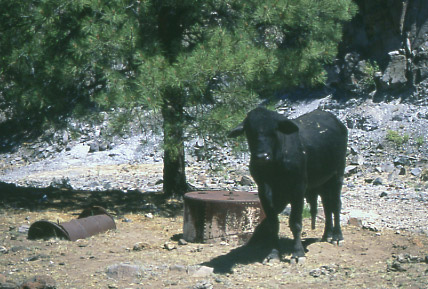 |
| “Trespass Bovine.” Prior to my visit, a court decision had mandated the removal of all cattle from the Diamond Bar Allotment to protect the endangered Gila trout. Livestock grazing was to end permanently on roughly 40% of the 145,000-acre allotment, with the remainder closed for a minimum of five years. Adobe Canyon, Gila Wilderness, NM.
Early July 1997. |
| I conclude this section with two examples of riparian areas damaged by ranching elsewhere in the West. |
|
|
|
 |
|
Redband trout spawning habitat trampled by cattle. Magpie Creek, Castle Creek Allotment, ID. Mid-August 1998. |
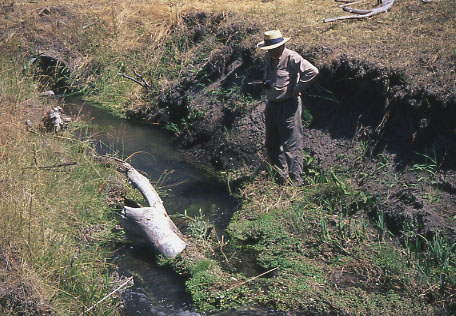 |
| Damage by cattle to this creek is evident, not only by the absence of riparian trees, but also by the down cutting of the banks which occurred by the late 19th century. Harold Winegar, retired Oregon Department of Fish & Game biologist standing in the photo, says this would be a good trout stream were it not for the cattle. Gibson Creek,
Ochoco National Forest, OR. Early August 1998. |
|
Upland Forests
Approximately 97 million acres of lands managed by the U.S. Forest Service in the western United States are grazed by livestock.
Belsky & Blumenthal (1997) report that livestock grazing can negatively impact forest structure and forest health. |
|
|
|
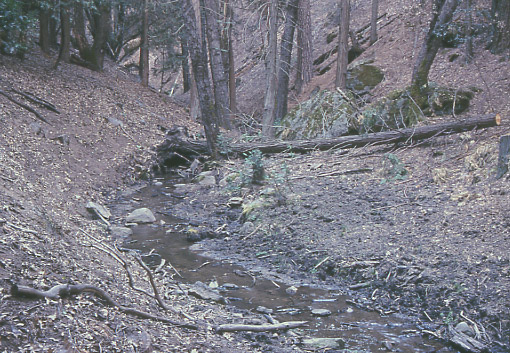 |
| By grazing Von Hellum Creek from early May to mid June, cattle remove virtually all new vegetation.
Sequoia National Forest, CA. Mid-August 1999. Sunset.
This photo appears in
Welfare Ranching (2002), 134–35. |
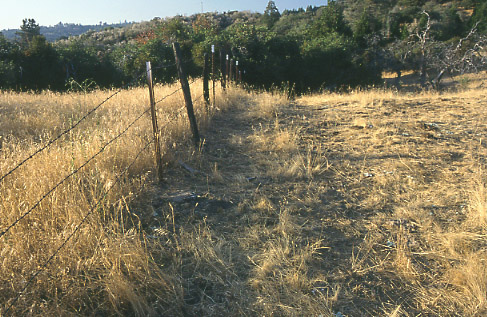 |
| Along the road to Von Hellum Creek I passed this divided field. Ungrazed private land is on the left; cattle-grazed Sequoia National Forest is on the right. Were not so much forage on public lands allocated to cattle there would be much more available to support healthy wildlife populations. Mid-August 1999. Late afternoon.
|
 |
Perennial grasses have extensive roots that stabilize soil against flowing water. Incessant cattle grazing reduces these roots thereby leading to increased erosion. This drainage in a heavily grazed field has eroded to a width of five feet. Upon entering ungrazed, grass-covered, private land beyond the fence the drainage narrows to about one foot. Along the road from Posey to Von Hellum Creek.
Sequoia National Forest, CA. Mid-October 1997. |
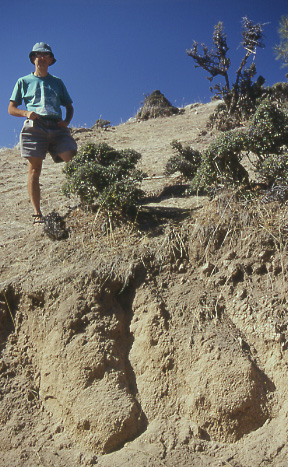 |
“Bonsai Forest.” Had cattle not relentlessly “pruned” these trees over several years they would well exceed my height. Sequoia National Forest near Posey, CA. Mid-October 1997. |
|
Grasslands
The desert and semi-desert grasslands of Arizona, California and New Mexico have been grazed by sheep and cattle since the 1860s, and in some locations since the early 1600s. By the late 19th century many of the native, perennial grasses had succumbed to this intense grazing thereby opening the way for short-lived weeds to take their place. This conversion is readily apparent during dry seasons after the weeds have blown away.
California’s Carrizo Plain, still designated as a natural area at the time of my visit in December 2000, has since been declared a national monument. Unlike most national monuments, though, management of the area will remain under the Bureau of Land Management (BLM) rather than the National Park Service. The BLM’s focus on commodity extraction, rather than resource protection, is reflected by only 27,000 of the monument’s 203,000 acres being off-limits to livestock. |
|
|
|
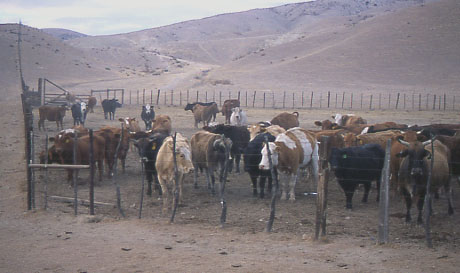 |
| Cattle corralled at the south end of the Carrizo Plain Natural Area await the late fall rains before being turned loose. Carrizo Plain National Monument, CA. Early December 2000. Sunset.
This photo appears in
Welfare Ranching (2002), 160–61. |
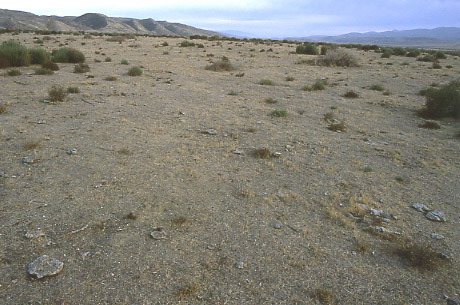 |
| Among the wildlife species harmed by cattle grazing on the Carrizo Plain is the Endangered
giant kangaroo rat whose burrows can be crushed. The rat’s unique method of closely cropping vegetation in a meandering pattern provides habitat and foraging niches for a wide variety of wildlife. After intense grazing by cattle, though, no grass remains for the rats to crop.
Carrizo Plain National Monument at UTM coordinates 0266543/3880349. Early December 2000. Late afternoon. |
| Landscapes that have been similarly devastated by sheep or cattle can be found throughout the Southwest. |
|
|
|
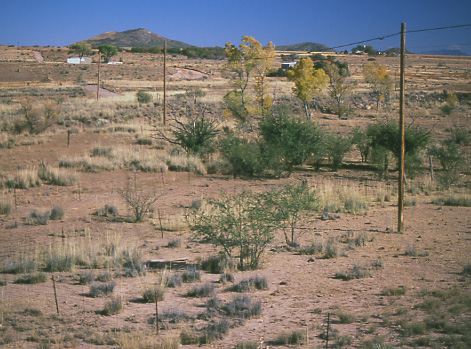 |
This degraded 171-acre parcel of state land on the Babocomari River near Elgin, AZ, was the subject of a lawsuit brought in 1997 by
Forest Guardians (currently WildEarth Guardians) and
Western Gamebird Alliance. The lawsuit challenged the policy of awarding land leases to ranchers despite higher bids from non-ranchers.
In November 2001 the Arizona Supreme Court overturned an earlier ruling by the Arizona Court of Appeals in declaring that Land Department officials “may not summarily disregard and label restorative uses as inappropriate for grazing land.” In May 2003 Forest Guardians outbid the current permittee and was awarded the ten-year lease for the allotment. The organization plans to not only keep the parcel free of cattle, but to actively restore streamside forests and desert grasslands. Early November 1997. |
| A few miles south of this cattle-ravaged wasteland lies the
Appleton-Whittell Research Ranch, informally known as the Audubon Ranch. Although a cattle ranch until 1969, it has since been a facility for research on the restoration of native grasslands after removal of cattle. According to a publication of the research ranch, “By 1990, canopy cover of upland perennial grasses averaged 61% on the Research Ranch compared to 41% on adjacent ranches ...” (Audubon 1997) Between 1969 and 1984 native grass species on the Research Ranch increased from twenty-two species to forty-nine. (Brady et al. 1989) |
|
|
|
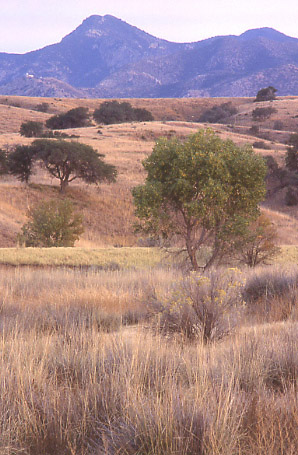 |
The Research Ranch abounds in native, perennial grasses. Even during dormant seasons these grasses provide cover and a source of food for wildlife. Appleton-Whittell Research Ranch, AZ. November 1997. Sunset. |
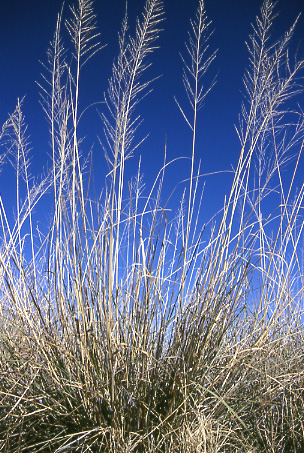 |
Sacaton (Sporobolus wrightii), reaching a height of six feet, is the tallest native bunchgrass in southern Arizona and the most spectacular of the grasses on the Research Ranch. The vegetative community comprised of Sacaton, interspersed with herbaceous annuals, provides cover and forage for
javelina,
deer and other wildlife. Throughout the Southwest, farming, livestock grazing and water diversions have reduced Sacaton communities to only 5% of their former range. Thus also, the Sacaton dependent population of
Botteri’s sparrow
has been severely decimated.
Appleton-Whittell Research Ranch, AZ. Early November 1997. |
| Another Arizona grassland undergoing restoration resides within the boundaries of the
Buenos Aires National Wildlife Refuge> southwest of Tucson, AZ. Like the
Appleton-Whittell facility, this region was formerly a cattle ranch. Fortunately for wildlife, some native, perennial grasses survived the presence of cattle. Since 1985, refuge managers have employed controlled burning to give those grasses a competitive advantage over exotic, annual species in expanding their range. |
|
|
|
 |
Tanglehead (Heteropogon contortus) and other perennial grasses provide yearlong forage and cover for wildlife, including the ground-nesting
masked bobwhite quail (Colinus virginianus ridgewayi) for whose reintroduction the refuge was established.
Buenos Aires NWR, AZ. Early November 1997. Early morning. |
| A few miles north of the Buenos Aires refuge and west of AZ Rt. 286 lies cattle-grazed state land whose degraded soil supports only annual grasses. |
|
|
|
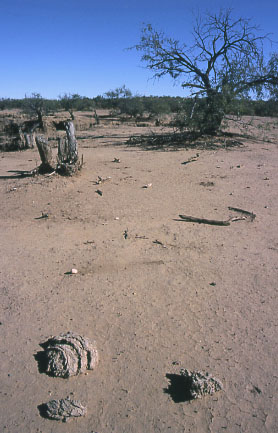 |
Cattle-grazed annual grassland during the dry season. Small mammals, reptiles and ground nesting birds such as the
masked bobwhite could no longer survive here by the late 19th century due to lack of cover—predators easily picked them off. With no prey remaining, predator populations also crashed. Arizona State Land west of Route 286 at Mile Mark 30. Late October 1997.
This photo appears in
Welfare Ranching (2002), 40. |
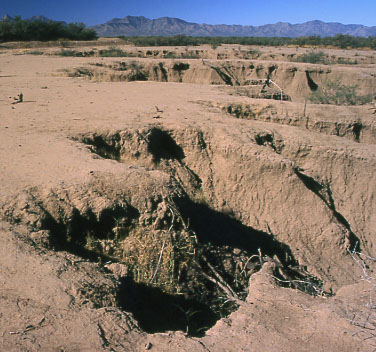 |
| Livestock grazing, begun in the 1870s, has extirpated the native, perennial grasses and opened the way for their replacement by annuals. Lacking permanent root structures, annuals are incapable of holding the soil during summer “monsoon” rains. Arizona State Lands west of AZ Rt. 286 at Mile Mark 30. Late October 1997. |
Sometimes It Goes Really Badly For The Cattle
Ranching in the arid West inflicts numerous hardships upon native plants and wildlife. Under harsh environmental conditions even cattle can face suffering and unpleasant, premature death. Such was the case when southern New Mexico experienced severe drought during the spring of 1996. Plant growth ceased and cattle consumed all the existing palatable vegetation. By May at least thirty of 240 head on the Cold/Hot Springs Allotment in the
Gila National Forest had died and an estimated twenty more subsequently perished. Death resulted not just from starvation, but from ingesting toxic vegetation such as
locoweed
which cattle normally avoid. In June 1997 I visited the Gallinas Canyon region of the allotment and found it littered with the skeletons and rotting carcasses of these unfortunate bovines. |
|
|
|
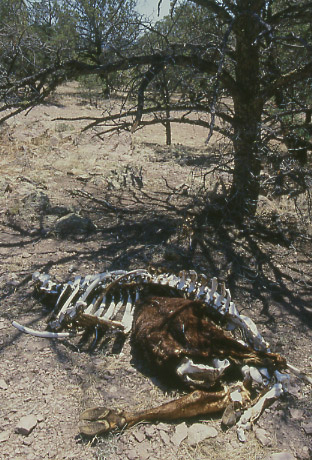 |
Perhaps the tree’s cool shade drew this doomed cow to its final resting place. Gallinas Canyon, Cold/Hot Springs Allotment,
Gila National Forest, NM. Late June 1997. |
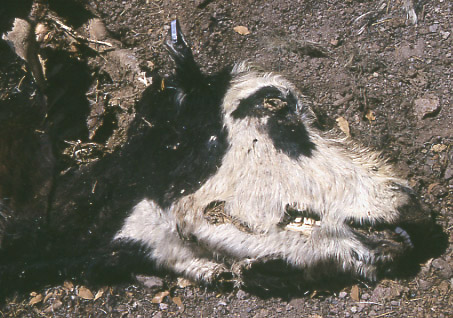 |
| Although dead for more than a year this cow’s remains had decomposed little compared to those of most drought victims. Scavengers, though, had apparently dined on the carcass. Gallinas Canyon, Cold/Hot Springs Allotment, Gila National Forest, NM. Late June 1997. |
Disturbed by what you’ve seen here?
|
|
Western Turf Wars is a must read for everyone who wants to better understand the politics behind the management that’s led to the appalling environmental conditions displayed in this photo essay. Western Turf Wars is filled with compelling stories by the courageous men and women inside and outside govenment agencies who in standing up to the livestock industry have often paid for their actions with persecution in the workplace and in the communities where they live.
|
|
 |
|
|
|
|
|
References
AES and USFWS. 1999 (29 July). Biological Opinion: On-Going & Long-Term Grazing in the Coronado National Forest. Arizona Ecological Services and U.S. Fish and Wildlife Service.
AGFD. 1988. Threatened Native Wildlife in Arizona. Arizona Game and Fish Department.
Audubon. 1997 (April). Grasslands of the Research Ranch. National Audubon Society, Appleton-Whittell Research Ranch, Elgin, AZ.
Belsky, A. Joy and Dana M. Blumenthal. 1997.
Effects of Livestock Grazing on Stand Dynamics and Soils in Upland Forests of the Interior West. Conservation Biology 11, no. 2 (April): 315–27.
Brady, W. W., M. R. Stromberg, E.F. Aldon, C. D. Bonham, and S. H. Henry.
1989. Response of a Semidesert Grassland to 16 Years of Rest from Grazing. Journal of Range Management 42, no. 4 (July): 284–88.
NMDGF. 1985. Handbook of Species Endangered in New Mexico. New Mexico Department of Game and Fish.
|
|
|
|
Text and Photos © 2004– by Mike Hudak, All Rights Reserved
|
|